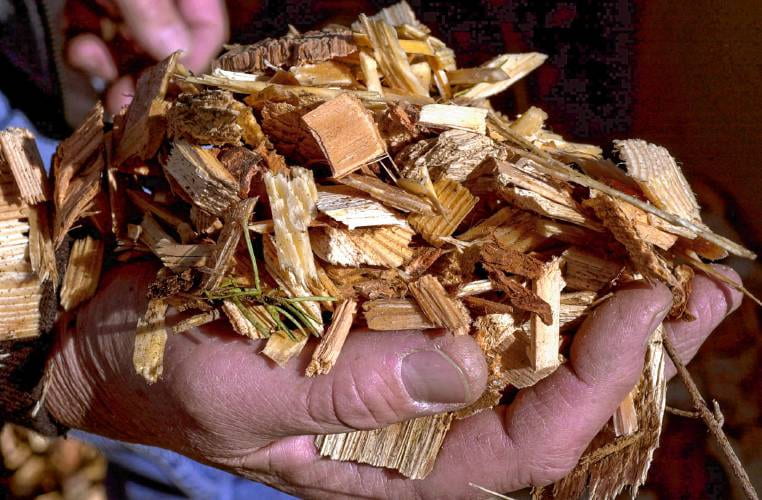Yep, you read that right. Using a fake Christmas tree this year might actually be the environmentally conscious thing to do. It may be surprising to hear the approach I’m taking in the age-old argument between buying real or fake Christmas trees. However, before you clap your hands over your eyes and start fa-la-la-la-la-ing to drown out my article, consider that the health of our forests and the viability of future Christmas trees may be at risk.
Meet the elongate hemlock scale, an invasive insect whose population is snowballing in New England’s Christmas trees and threatens to spread across the East Coast. Humans are unwittingly playing a large role in that spread. By shopping locally, inspecting our trees, and properly disposing of them, or by using a fake Christmas tree, we can reduce the spread of the elongate hemlock scale.
Tree branch infested with elongate hemlock scales. Source: Minnesota State Department of Agriculture
Elongate hemlock scales, native to Japan and China, are tiny insects that feed on the sap of plants and steal the fluids and nutrients the tree needs to be healthy. The brownish-yellow pest can usually be found on the underside of tree needles, latched on with mouth suckers, and covered in a protective waxy substance. They spread during the “crawler” phase of their life cycle when they can move around on trees. They transfer hosts through contact, by being digested and moved by birds or other animals, or even by being blown to a new host on the wind.
For most Americans, long-past are the days of taking a trip to a national forest to chop down your own tree. Nowadays, people prefer convenience when picking out a living room companion. Thus, the creation of Christmas tree farms. The majority of Christmas trees supplied to the Northeast are grown on farms in North Carolina and then shipped to sellers in different states. Here’s the bad news: elongate hemlock scales have started to invade southern East Coast states like North Carolina. The invasion, previously contained to New England forests, could soon be shipped to locations down the east coast and further into the midwest.
The worst part of the growing Southern infestation is that the elongate hemlock scale can have two staggered life cycles each year with warmer winters. This means that the crawlers are a year-round issue. When sellers import Christmas trees from states like North Carolina, trees with active crawlers are introduced to the system, furthering their spread. The terrible confluence of these factors makes elongate hemlock scales extremely likely to spread this holiday season.
Selecting fake Christmas trees could be extremely beneficial towards stopping the spread in the long run. Usually, the argument for buying real Christmas trees over fake ones goes like this: buying real trees helps support Christmas tree farms whose trees provide habitat and serve as a carbon dioxide sink. Buying fake trees creates a demand for more fossil-fueled plastic and requires transportation from far away countries where the trees are manufactured, incurring large carbon emissions in the process. These points are still valid, however, this year buying real trees can also cause massive ecosystem disruption. Using a fake tree this Christmas might protect your option to buy real Christmas trees in the future. The best choice would be to purchase a second hand or thrifted Christmas tree to minimize the carbon footprint.
However, if you do plan to chop your own tree or go to a local Christmas tree farm, be sure to check for signs of an invasive species infection in the tree. Elongate hemlock scale tree invasions are usually identified by having yellowing branches and a thin crown of the tree. In severe infestation, you should also be able to see the larger brown female scale on the underside of the needles.
Yellowing branches of an elongate hemlock scale infested tree. Source: eXtension
Another way to prevent the spread is to deck-the-halls with local plant species. Even though it may not be a traditional decoration, native-plant inspired homemade wreaths, centerpieces, and lawn decorations can be a fun and unique project to make with family members.
If you do decide to buy a real tree, when the sad day comes to take it down remember to dispose of it responsibly. Most areas have a recycling program that will properly dispose of any invasive species that might have gone undetected in the tree. When infested trees are abandoned, the elongate hemlock scale crawlers can move to new areas and infest additional local nature that could have remained undamaged. Find a Christmas tree recycling program near you here. If you do find an elongate hemlock scale, please report it to your state government’s department of agriculture website.
Close up image of a female elongate hemlock scale under a tree needle. Source: Penn State Extension Website
This holiday season, I urge you to consider using a fake Christmas tree to stop the spread of this pesky pest. Although elongate hemlock scales are the Grinch this Christmas, decorating responsibly will help keep everyone’s holiday season merry.























